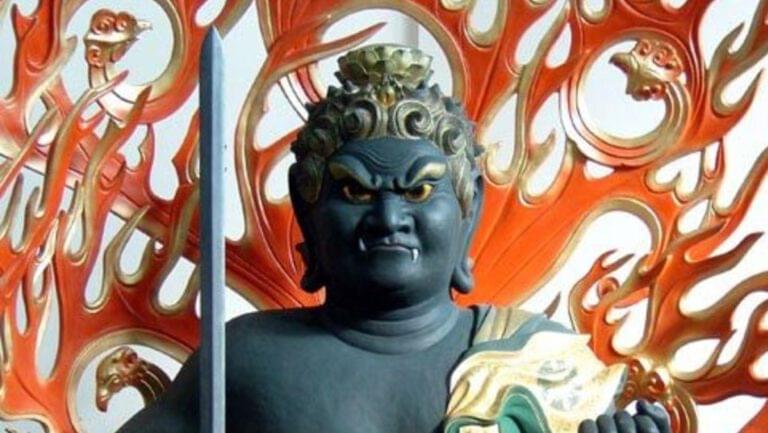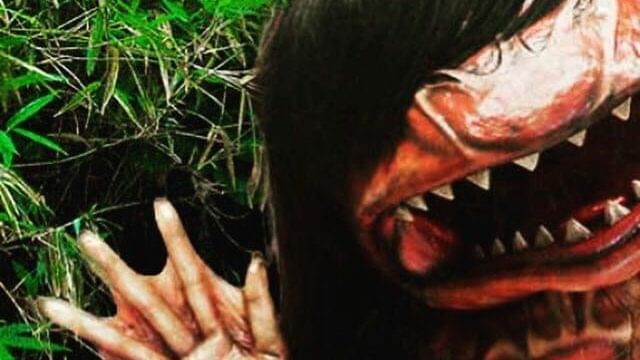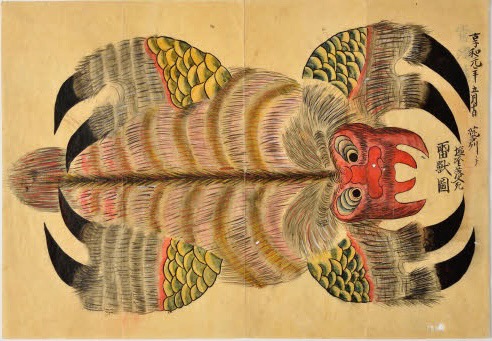The summer heat in Japan is shattering and inescapable. Why not go to the beach to cool off? I’ll tell you why not. Because there’s something lurking on the coasts that is far more dangerous and horrific than an insidious rip current and a nasty case of sunburn.
Hey, hey, this is Thersa Matsuura, author of the book of Japanese folklore and coming in November of 2025, the Yōkai Oracle Deck. If you pre-order now, you lock in the price, because who knows what’s going on with the tariffs. Anyway, you’re listening to Uncanny Japan, brought to you by the awesome network, SpectreVision Radio, and here I share with you all those lesser known, fascinating, and sometimes frightening corners of Japanese culture.
On today’s show, you’ll be accompanied by the soothing sounds of the ocean. Richard and I braved the heat and the danger that you’re going to learn about in a second. And recorded some cool waves, lovingly lapping the shore.
Let the steady, timeless pulse of the sea lull you into a false sense of security, while I tell you what will happen if you’re not careful.
For patrons, I’ll put up a Waves Only MP3 over on the Uncanny Japan Patreon page for sleep, study, or otherwise escaping the stressors of life. And for kitsune-tiered and above patrons, there’s an ad-free version of the whole show.
So go grab your sunscreen and a towel. We’re going to the beach.
Japan’s Vast Coastline Geography
How many islands do you think make up Japan? Did you say four, five? Wrong. Did you say 6,852? Also wrong, although you would have been correct on that last number until recently. It used to be 6,852 when, 36 years ago, the Coast Guard sailed around and counted. They didn’t do a very good job, though. They weren’t even close.
In 2023, using more modern digital mapping technology, the Geospatial Information Authority of Japan did a new count, and they came up with 14,125 islands. More than double. That’s a lot of coastline.
Basically, and I’m not really exaggerating here, to live in Japan, you have to squeeze into a space between all the mountains, throw in 111 active volcanoes and the immense, still mostly unmapped, treacherous sea. Only about 27% of the entire country is habitable.
You can kind of understand, then, why Japan is so full of monsters. There’s all your land-based creatures in the forests and hills. You’ve got your oni ogres, tengu mountain goblins, and kitsune foxes, to name only three on one side, and then you have your ocean-based beasties on the other.
I’ve talked a little bit about boat ghosts, funayūrei, and sea monks, umibōzu, in episode 20. I also talked in episode 83 about ningyo, or Japanese mermaids, at the very beginning of COVID, in episode 49, and that poor mermaid that washed up off the coast back in 1803, episode 78. But there are so many more.
When you meet your end on a rugged shore of Japan, you might as well know which yōkai you’re dealing with.
The Legendary Iso-onna: Shore Spirit
Let’s look first at iso-onna. Iso-onna’s history doesn’t go back as far as the second century like some yōkai, but she still has quite the reputation.
Iso-onna appears to her victim on an otherwise empty beach. She’s described as a beautiful woman with long black hair, so long it drags along the sand. You might see her standing on the shore or sitting on a rock, combing that gorgeous hair.
Iso-onna’s weapon of choice is that long, beautiful hair. She uses it like a lasso to wrap around her victim’s neck or limbs, and then she drags them into the water where they drown.
Iso-onna is also the bane of fishermen and sailors. In Kitakyūshū, they say iso-onna are some kind of sea snake that can take the form of a woman. They’re known to climb aboard fishing boats at night, and if you’re sleeping on the shore or on the deck, she might just strangle you with that hair or drag you overboard to your death.
In the dark, I’d probably think it’s a ninja before considering it might be an iso-onna climbing up the side of a boat with nothing but hair and fingernails. It’s rumored that she can actually walk on water.
One way is to anchor a ways offshore. But if you have to sleep on the beach, make sure you’re in an area known for tales of iso-onna. They will arrange their clothes and straw sandals in a neat pile before going for a late night swim.
But if she’s an iso-onna, her bottom half is usually that of a snake, so there won’t be any sandals to leave them out on the sand in the first place.
But let’s hope it really was an iso-onna, or you might have encountered our next coastal terror, whose modus operandi for taking people out is much more violent, if you can believe that.
Nure-onna: The Wet Woman of the Waves
It’s the nure-onna. The name is perfectly monickered to express just that. Nure means wet, and onna means woman.
The nure-onna appears as a woman with long black hair, but instead of legs, she has the body of a large snake. Those unfortunate enough to run into a nure-onna describe her as having the head and torso of a beautiful woman, but from the waist down, she’s all serpent.
How do you identify the nure-onna? She has another, more devious trick up her proverbial sleeve. The nure-onna will approach her victims while holding what appears to be a human baby. She’ll beg you to hold the child for her while she does something with her hair or adjusts her clothes.
The problem is, as soon as you take that baby, it becomes heavier and heavier until you can no longer move. You’re stuck. That’s when she reveals her true nature and attacks.
Ushi-oni: The Ox Demon of Waters
The ushi-oni, or ox demon. An ushi-oni, or sometimes called a gyūki, which is just a different way of writing the same creature.
Imagine a gigantic spider with the head of an oni, all fangs and horns and burning red eyes. Well, these ushi-oni like to hang out in or around water. Not like the iso-onna who just toddles off after finding her victim. The ushi-oni basically just wants to eat you whole, or rip you apart with its claws and teeth.
Their breath is poison, and if they lick your shadow, you’ll die. But what’s really frightening is that sometimes they do like to team up with the nure-onna to do just that.
Some say nure-onna is employed by the ushi-oni, or kind of works for them. She’ll lure victims close to the water’s edge or to the sea, and the ushi-oni will come out and feed.
There’s also something called nure-onnago. Another drenched damsel, but less snake, more traditional ghost woman who also has that incredibly long black hair that she uses as a weapon.
She’s related to something called the hari-onna, who uses her hair differently. Not like we talked about with iso-onna. Only hari-onna means “needle woman,” and the ends of her hair are like needles that she can shoot at you.
Instead of strangling you and dragging you into the water to end your life, like nure-onnago, she attacks with her hair, but it’s more like being shot by thousands of tiny arrows.
Staying Safe from Coastal Spirits
So other than digging sand out of your swimsuit, getting sunburned to a crisp, and avoiding the very real dangers of rip currents, now you know a few more things to watch out for when you’re enjoying Japan’s beautiful beaches.
If you enjoy learning about these more elusive topics of Japanese culture, I’d love to have you join me for more of my uncanny world. You can find links to my books on the website. The Book of Japanese Folklore is a small, beautifully illustrated hardcover where I dive into 45 yōkai and mythical figures.
My horror short story collection, The Carp-Faced Boy and Other Tales, now has an audio version, also read by me and perfect to fall asleep to. And coming out in November is the Yōkai Oracle Deck. Sixty yōkai matched with wise Japanese idioms, phrases, and those extremely nuanced words that have no equivalent in English, but you’ve always wanted to know how to say.
You can pre-order those if you’d like. There’s a clickable thumbnail on the Uncanny Japan website labeled Oracle Cards. Thank you so much for listening. Stay safe and well, and I’ll talk to you again in two weeks.






